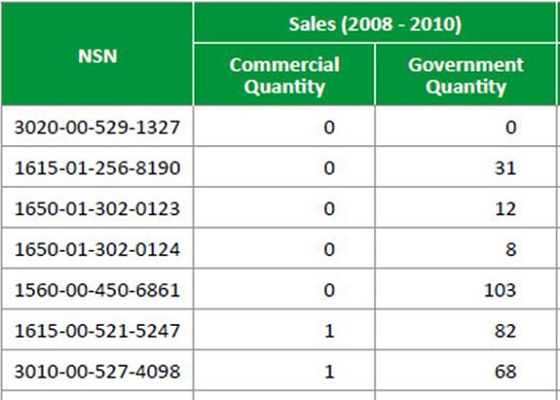
Spare Parts Overcharges: That's Why DoD's Budget is So High
Posted On:More than 30 years after the $7,600 coffee pot and the $436 hammer, weapon spare parts overcharges remain the clearest example of how the Department of Defense (DoD) wastes billions in taxpayer dollars. Numerous audits by the DoD Inspector General (IG) have unearthed Boeing overcharging up to 177,000 percent for spare parts, Sikorsky charging $2,393 for a $181 Black Hawk part, Hamilton Sundstrand increasing part prices by as much as 900 percent, and other examples of outrageous overcharges. But understanding the scope of the problem becomes harder when the Pentagon’s independent watchdog redacts the true scale of the overcharges, and preventing it is impossible as long as the DoD is forced to use an ill-defined definition of commercial items.
The DoD IG recently released a redacted version of a July 2014 report that found the Defense Logistics Agency (DLA)—the Pentagon’s hardware store—potentially overpaid Bell Helicopter (a subsidiary of Textron) $9 million on 33 of 35 sole-source commercial parts. That the parts were designated commercial and bought on a sole-source contract essentially means there was no competition and the government won’t receive any pricing data from the company. The prices of the individual parts, and the percentage of the overcharges, are all redacted in the DoD IG’s release as (b)4 exemptions to the Freedom of Information Act—commercial proprietary information. But Tony Capaccio at Bloomberg Business filled in the gaps of overcharges that ranged from 3 to more than 17 times the fair and reasonable price including:
- $8,124 for a $445 bevel gear
- $492.17 for a $36.08 straight-headed pin
- $237.51 for a $25.86 shim
- $29.95 for a $7.49 sleeve spacer
The Project On Government Oversight has obtained the unredacted report, which includes a litany of additional examples. On average, the overpayment for the parts analyzed was 392 percent, and DoD IG expected DLA would waste another $2.6 million over the next year under the contract.
Last July, when Representative Jackie Speier (D-Calif.) (my former boss) asked Pentagon acquisition chief Frank Kendall about these overcharges, he told her, “I think what you described is basically fraud: someone who’s charging us 10 times what something costs.”
While POGO understands that the pricing data can be sensitive proprietary information, we were surprised that the DoD IG redacted its own analysis of the overcharges until we discovered that Bell Helicopter refused to release any pricing information to the contracting officer or the DoD IG until the IG issued a subpoena. Contracts often state that contractors have a partnership with the government, but what partner requires a subpoena before turning over information to other partners?
Assessing Fair and Reasonable Prices
The DoD IG found that the contracting officer did not perform a historical price analysis or sufficient sales analysis to determine if the commercial, sole-source parts were sold to the government at a fair and reasonable price. Contractors do not need to provide certified cost data when the items they’re selling the government are genuinely commercial—meaning they are actually offered for sale on the general market. This kind of sole-source commercial contract shows why contractors should have to. “Because adequate competition does not exist, the acceptance of the market-based price as fair and reasonable is questionable on a sole-source contract,” wrote the DoD IG. Even worse, they found that seven parts weren’t really sold in commercial quantities—meaning they weren’t sold on the general market—because they were sold in quantities of 0 or 1:
Without certified pricing information, contracting officers are required to request other information to support their cost analysis. Looking at how much the DoD had previously paid for the part in the last contract, the contracting officer found 229 parts with a price increase greater than 25 percent and asked for additional information to justify reasonableness. Bell refused to provide non-certified cost data—and has denied similar requests since 2008. The contracting officer removed the parts from the negotiations, but left in parts with price increases below 25 percent—and ultimately paid prices as much as 852.5 percent higher than historical prices.
These discrepancies could only be found because the DoD IG has subpoena authority. The DLA doesn’t have subpoena authority and is stymied when contractors don’t want to help them determine if the commercial prices are really fair and reasonable. The discrepancies will continue to occur until Congress adopts the Defense Department’s proposal to narrow the definition of commercial items to mean goods or services that are actually sold to the public in “like” quantities. It’s an overdue reform that POGO Executive Director Danielle Brian recommended to now-Senate Armed Services Chairman John McCain (R-Ariz.) as far back as 2005.
A new, more accurate definition of commercial items ensures the government can purchase genuinely commercial items easily and can substantiate pricing information and reasonableness for non-commercial items, especially for non-competitive purchases. This means taxpayers can save money. We also must make the contracting process easier, so contracting officers no longer have to scurry around to do market research. The system is broken and Congress should pass DoD’s proposed solutions.

